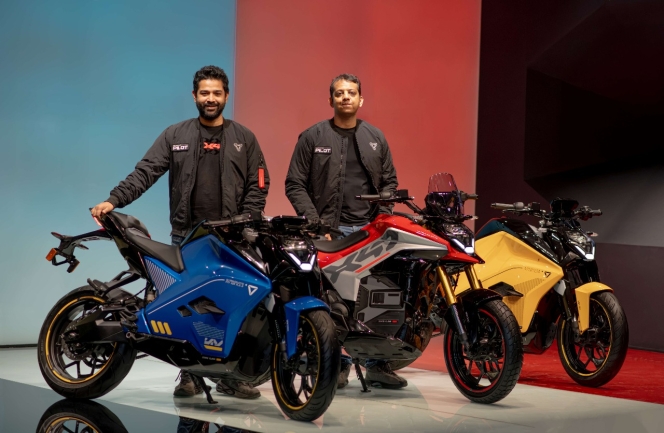- 2025 season
- 75th anniversary year
- Formula 1 sport
- progress
- sustainability
- social commitments
- 2024 Impact Report
- Net Zero
- goal for 2030
- Formula 1 sport
- environmental front
- significant investments
- Sustainable Aviation Fuel (SAF)
- ultra-efficient logistics strategy
Formula 1 Reports On Sustainability And Social Progress Across 2024 Season
- By MT Bureau
- March 13, 2025

Returning for the 2025 season and 75th anniversary year this weekend, the Formula 1 sport has released a round-up on the progress made towards its sustainability and social commitments last year. In the form of 2024 Impact Report, which will be released later this year, the progress made towards its sustainability and social commitments with Net Zero as the goal for 2030, the Formula 1 sport has – on the environmental front – made significant investments in Sustainable Aviation Fuel (SAF) as part of its ultra-efficient logistics strategy.
It has invested significantly in SAF as it delivers an estimated 80 percent reduction in associated carbon emissions per flight compared to the use of conventional aviation fuel. The combined investment in SAF with Global Partners DHL and Qatar Airways reduced total related emissions by more than 8,000 tCO2e (tonnes of carbon dioxide equivalent), an approximate 19 percent reduction in related emissions– compared to traditional aviation fuel – for the air freight charter programme operated by Formula 1 across the flyaway events of the 2024 season.
The delivery of innovative low-carbon energy generation systems using renewable sources such as hydrotreated vegetable oil (HVO), biofuel, solar panels, and battery began testing in 2023. Last year, they were used at the Red Bull Ring, the Hungarian Grand Prix and the Italian Grand Prix in Monza. For the 2025 season, a programme will be rolled out to reduce more than 90 percent of carbon emissions at all European Grands Prix in key areas such as the Paddock, Pit Lane, and Event Technical Centre.
As part of the sport’s ongoing efforts to reduce carbon emissions associated with travel and logistics, improvements were made to the geographical flow of races around the world in 2024. This included agreement from the Promoter in Japan to move the Suzuka race back from September to April to fit with the Asia Pacific segment of the schedule, while Azerbaijan took its slot to align with Singapore. The organisers of the Qatar Grand Prix also approved a move to the penultimate spot in the schedule, back-to-back with Abu Dhabi. From 2026 the Canadian Grand Prix will be hosted earlier in the year and the Monaco Grand Prix will take place on the first full weekend in June, consolidating the European leg of the F1 season into one period, removing an additional transatlantic crossing and delivering significant associated carbon reductions.
Last year, F2 and F3 cars ran on 55 percent Aramco advanced sustainable fuel and the FIA medical and safety cars operated on 40 percent of it. In 2025, the F2 and F3 cars will move to 100 percent use of it, ahead of the Formula 1 cars adopting the fuels in 2026 in the new hybrid engines that will take to the circuit next year.
The technology has implications for the automotive industry and existing petrol cars, as the fuel developed by Formula 1 will be a ‘drop-in’ that can be used in road cars without modification and will serve as a sustainable alternative of global benefit.
Throughout the 2024 season, the cars all operated with FSC approved Pirelli tyres, which means the natural rubber in the type complies with the FSC’s strict standards for sustainable forestry. Some 80 percent of promoters powered aspects of their events using alternative energy sources such as solar panels, green tariffs, and biofuels. Over 90 precent of promoters began offering greener ways to travel to the race.
On the social commitments front, the Formula 1 sport – in 2024 season – marked the fourth year of its F1 Engineering Scholarships programme, which would support 50 underrepresented students by the end of 2025. The Scholarship covers the entire cost of the student’s tuition, together with living expenses for the full duration of their degree, enabling them to focus on their studies. It also offers them support to set them up for their careers, including work experience with one of the ten Formula 1 teams, as well as career workshops and mentoring.
Formula 1 also launched the global education programme ‘Learning Sectors’ in collaboration with the British Council to inspire young learners in Brazil, India, South Africa, and the UK to pursue STEM subjects. The year long programme kicks off this year with 130,000 students in 700 schools.
F1 Academy, the sport’s female-only series, competed alongside Formula 1 at seven events last year, completing 21 races. Through F1 Academy’s partnership with the international karting series, Champions of the Future, female participation in racing increased from five percent in 2023 to 25 percent in 2024.
The sport also continued with hosting apprenticeships and workshops, such as The Next Grand Prix challenge in association with the Social Mobility Business Partnership (SMBP) charity, which challenges students aged between 16 and 18 from a breadth of backgrounds to assume a business leadership role and deliver a fictional bid for a new Formula One World Championship location.
Ellen Jones, Head of ESG at Formula 1, said, “Innovation and community drove Formula 1's work in 2024. We are thrilled to outline our progress and continued work in this space. Formula 1 as a sport is uniquely positioned to take action through our global reach and technological leadership.”
Neusoft And MapmyIndia Partner For Intelligent Mobility Solutions
- By MT Bureau
- December 06, 2025

Chinese technology company Neusoft Corporation and Mappls MapmyIndia have signed a Memorandum of Understanding (MoU) to leverage their strengths in software and data resources to collaborate deeply.
The companies will engage in joint technological development, ecosystem collaboration and resource integration to provide navigation products and intelligent mobility solutions tailored to localised needs in emerging markets such as Southeast Asia and India.
The partnership is a response to the fact that while global auto brands are expanding into Southeast Asia and India, they face challenges in these regions due to complex road conditions, unique traffic rules, extensive addressing systems and high localisation adaptation costs. These issues limit the ability of automakers to deliver a complete intelligent user experience.
Under the collaboration, Neusoft will adopt its OneCoreGo Global Intelligent Mobility Solution 6.0 Plus as the core technology carrier, deeply integrating MapmyIndia's map data, real-time traffic information and multi-dimensional value-added services. MapmyIndia is noted as the largest local mapping company in India, holding more than 90 percent market share in in-vehicle navigation.
The integration is intended to strengthen a full capability loop of ‘navigation + payment + interaction + connectivity + operations’.
Through API integration and technological convergence, the two parties will jointly develop navigation products and mobility solutions highly adapted to Southeast Asia, India and similar regional markets. These solutions will deliver precise route planning and real-time traffic guidance, address local user needs and continuously enhance product experience and scenario-based services. This will help automotive partners rapidly launch intelligent vehicle models with competitiveness in local markets.
The partnership enables Neusoft to combine the global end-to-end strengths of its solution with localised ecosystem resources, paving the ‘last mile’ for automakers entering the Southeast Asian and Indian markets and delivering comprehensive intelligent mobility experiences.
- Ultraviolette Automotive
- Zoho Corporation
- Lingotto
- F77
- X-47
- Shockwave
- Tesseract
- Narayan Subramaniam
- Niraj Rajmohan
Ultraviolette Secures $45 Million Growth Capital From Zoho And Lingotto
- By MT Bureau
- December 04, 2025

Bengaluru-based electric vehicle maker Ultraviolette Automotive has secured USD 45 million from Zoho Corporation and Lingotto, one of Europe's investment management companies as part of its ongoing Series E investment round.
The investment from Zoho Corporation was led by Sridhar Vembu, Mani Vembu and Kumar Vembu.
This growth capital will accelerate the domestic and international scale-up of current products F77 and X-47, as well as future product platforms Shockwave and Tesseract.
Ultraviolette has built a design and technology-led enterprise with the F77 and the recently launched X-47.
The company has expanded to 30 cities across India in a short span of 12 months and is expanding to 100 cities by mid-2026. The F77 motorcycles were recently launched in the United Kingdom, bringing Ultraviolette's presence to 12 countries across Europe.
Narayan Subramaniam, Co-Founder & CEO, Ultraviolette Automotive, said, “We are glad to announce our Series E investment from Zoho and Lingotto. Lingotto's legacy of backing iconic performance and mobility brands, combined with Zoho's long-term commitment to fostering cutting-edge Indian innovation, aligns perfectly with Ultraviolette's mission to build category-defining electric mobility solutions for India and global markets.”
Niraj Rajmohan, CTO & Co-Founder, Ultraviolette, said, "With the ongoing Series E investments, we are doubling down on growth and expanding our production to meet increasing demand. Our focus is on advancing breakthrough battery technology, elevating performance capabilities and expanding production to support upcoming product platforms. This investment will accelerate our journey towards scaling into India and global markets."
Disseqt AI Partners Tata Technologies And Infosys For Agentic AI Adoption
- By MT Bureau
- December 04, 2025

Agentic AI platform Disseqt AI has announced a partnership with Tata Technologies and Infosys. As per the agreement, Disseqt AI will assist both companies' IT and DevOps teams in developing and fast-tracking the production of tailored Agentic AI applications for automobile and FinTech companies globally.
The partnership aims to help auto and FinTech firms embrace customised Agentic AI faster and in a secure manner.
Disseqt AI, which has operations in Bengaluru, San Francisco and Dublin, provides an enterprise-grade platform for IT and DevOps teams. The company claims its platform cuts down Agentic AI testing and operations cost by 70 percent and improves productivity by up to 80 percent. The platform allows these teams to test, simulate and monitor their Agentic AI systems tailored across industries, ultimately enabling enterprises to operationalise tailored Agentic AI faster and at scale, without sacrificing ethics, governance and compliance.
Apoorva Kumar, Founder and CEO, Disseqt AI, said, “This is a landmark announcement for us as we further embed Disseqt into enterprise workflows for testing, simulation, monitoring and auditability purposes. We are already working closely with both Tata and Infosys on several projects and are proud to be part of their innovation initiatives”
Last month, Disseqt AI announced a strategic collaboration with HCLTech and Microsoft to guide financial services institutions with Agentic AI adoption.
Battery Passport Implementation Beyond EVs To Be Focus Of Barcelona Event
- By MT Bureau
- December 03, 2025

Battery and Energy Storage Europe has announced a programme focused on the EU Battery Passport, a regulatory milestone that becomes mandatory in February 2027. The Barcelona-based event will address the compliance gap for applications beyond the electric vehicle (EV) sector, which have dominated the conversation to date.
The event, taking place on 8th and 9th September 2026 at Fira de Barcelona's Gran Via venue, will focus on solutions and talks for applications that fall within the regulation's scope: stationary energy storage, industrial batteries, grid-scale systems, long-duration energy storage and emerging applications in aerospace, maritime and rail electrification.
With the February 2027 legal requirement date approaching, the programme will bring together industry leaders, technology providers, and policy experts to address the compliance challenges facing these diverse sectors.
The Battery Passport is a digital record documenting a battery's entire lifecycle, from raw material sourcing to production, performance and eventual recycling. From February 2027, it becomes mandatory for all rechargeable EV, industrial and LMT batteries over 2 kWh sold in the EU.
Linked via QR code, the passport will track each battery's complete lifecycle, including composition, carbon footprint and recycled content, fundamentally transforming supply chain transparency and sustainability practices across Europe.
The programme will explore implementation topics including digital infrastructure requirements, data management systems, supply chain integration, verification processes and recycling traceability.
Ken Davies, Conference Programme Director at Battery and Energy Storage Europe, said, "The Battery Passport represents one of the most significant regulatory shifts our industry has faced, yet many companies are still grappling with what implementation actually means for their operations. While the EV sector has dominated the conversation, there's a critical need to address how this regulation applies to stationary storage, industrial applications and the innovative battery technologies powering Europe's energy transition. With the clock ticking toward February 2027, Battery and Energy Storage Europe will shine a light on the practical implementation requirements for these often-overlooked sectors, connecting stakeholders with actionable solutions and bringing together the expertise, technology providers, and collaborative spirit needed to turn compliance into competitive advantage across the full spectrum of battery applications."





Comments (0)
ADD COMMENT